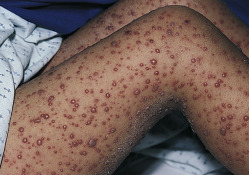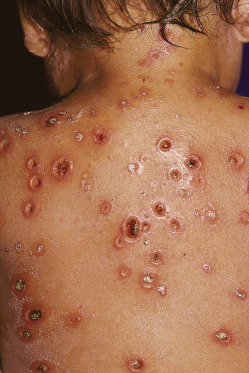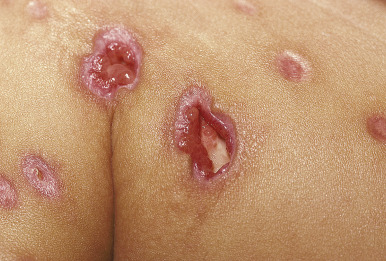AUTHORS: Abrar AlAbdulhadi, MD and Morgan Congdon, MD, MPH, MSEd
Varicella is a viral illness caused by varicella-zoster virus (VZV) and characterized by the acute onset of a generalized vesicular rash and fever.1
| ||||||||||||||||||||||||||||||||||||||||||||
- Varicella is extremely contagious. Approximately 60% to 90% of unvaccinated contacts become infected.
- Before the vaccine, ∼95% of children under the age of 5 were infected by VZV.1
- Transmission is via respiratory droplets, aerosolized vesicular contents, or direct contact with skin lesions.2
- The incubation period of chickenpox ranges from 7 to 21 days.
- The peak incidence is late winter and early spring.
- The contagious period begins 2 days before the onset of clinical symptoms and lasts until all of the lesions have crusted, an average of 7 days.
Approximately 3% of children may develop a benign varicella-like rash 5 to 26 days after vaccination.1
- Most patients will have lifelong immunity after contracting chickenpox; protection from the virus after a varicella vaccine is approximately 5 years and is more effective with a two-dose regimen.3
- After infection, VZV becomes latent in the sensory ganglia, with reactivation with herpes zoster (shingles) possibly decades later.2
- Primary maternal VZV during first or early second trimester causes congenital varicella syndrome in up to 25% of cases.4
- Findings vary with the clinical course. Initial symptoms consist of fever, chills, backache, generalized malaise, and headache.
- Children present with discomfort and malaise, while adolescents and adults are at risk for severe infection. Initial lesions generally occur on the head and face, trunk (centripetal distribution), and then extremities, but can appear anywhere, including mucous membranes.
- These lesions consist primarily of 3- to 4-mm red papules with an irregular outline that develop into clear vesicles with an erythematous base (Fig. E1) (i.e., the appearance of “dewdrops on a rose petal”).
- Intense pruritus generally accompanies the initial stage. Excoriations may be present if scratching is prominent.
- The fever is usually highest during the eruption of the vesicles; the patient’s temperature generally returns to normal after the disappearance of vesicles.
- New lesion development generally ceases by the fourth day, with subsequent umbilication and crusting by the sixth day.
- Lesions in varying stages of healing is a hallmark feature.
- Crusts generally fall off within 5 to 14 days. Scarring may occur in association with secondary bacterial infections (Figs. E2 and E3).
- Skin lesions may become superinfected by bacteria, including Streptococcus pyogenes (Group A strep) or Staphylococcus aureus.
- Signs of potential complications (e.g., bacterial skin infections, neurologic complications, pneumonia, hepatitis) may be present on physical examination. Acute cerebellar ataxia is the most common extracutaneous complication.
Large, deep scars are present in this patient who had secondary bacterial infection of her primary varicella lesions.
From Paller AS et al: Hurwitz clinical pediatric dermatology, a textbook of skin disorders of childhood and adolescence, ed 5, Philadelphia, 2016, Elsevier.
Figure E3 Varicella, complicated.
Deep, ulcerative lesions occurred in this young girl with underlying immunodeficiency and secondary infection of the skin with Streptococcus pyogenes.
From Paller AS et al: Hurwitz clinical pediatric dermatology, a textbook of skin disorders of childhood and adolescence, ed 5, Philadelphia, 2016, Elsevier.
Varicella-zoster virus (VZV) is a double-stranded DNA, human herpes virus III (HHV-3) that can manifest with either primary infection (varicella) or herpes zoster (i.e., shingles, which is a reactivation of latent varicella).1


